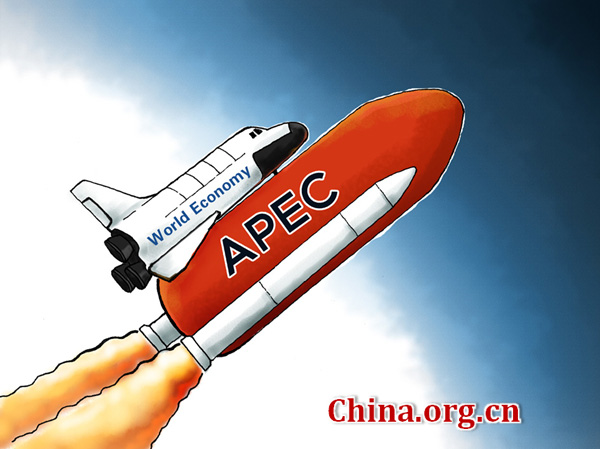Successes of China's economic diplomacy
- By John Ross
 0 Comment(s)
0 Comment(s) Print
Print E-mail China.org.cn, November 17, 2014
E-mail China.org.cn, November 17, 2014
|
[By Zhai Haijun/China.org.cn] |
There was a striking contrast between the highly focused APEC summit in Beijing and the sprawling somewhat directionless G20 summit in Brisbane. To start with, the Australian host of the G20 was rather elbowed aside in a fashion characterized by the U.K.'s Guardian as: "Obama puts climate change in spotlight as Australian agenda sidelined." Some G7 country delegations tried to turn the G20 into an attack on Putin over Ukraine – a pointless polarization as not only did the BRICS leaders meet at the summit, including Russia, but previous UN votes had shown most world governments would not line up behind U.S./West European policy on Ukraine.
READ: For a fair and just international system
The APEC summit in Beijing, in contrast, was sharply concentrated on interlinked themes of Asian infrastructure development and creating Asia-Pacific free trade areas, with a major announcement on a free trade agreement between South Korea and China during the summit, and a bilateral agreement on climate change announced by China and United States immediately after it.
This difference between the two summits, however, was not primarily due to the G20 meeting organizers, although the ineffectual attempts to keep climate change off the agenda and to "shirt front" Putin were not constructive, but reflected the overall situation in the world economy.
IMF Managing Director Christine Lagarde, in a striking phrase, characterized the current state of the global economy as "the new mediocre." Growth in two of the world economy's main engines, Europe and Japan, is essentially zero. U.S. economic expansion, in the year to the third quarter of 2014, was 2.3 percent – substantially below historic levels. Two BRICS economies, Brazil and Russia, are relatively stagnant. Some sub-Saharan African economies are expanding rapidly but are too small to determine the global economic situation.
It is the major Asian developing economies, therefore, which continue to undergo rapid growth. In the year to the third quarter of 2014, China's 7.3 percent GDP growth and India's 5.7 percent were lower than their own highest standards but far above the G7's. These two economies are the fundamental reason Asian economic expansion continues to be the world's highest.
Global economic trends are also reflected in popular moods and potential for social conflict. Feeding depressed popular attitudes in the G7 is the reality that even in some cases where economic recovery has taken place it has not translated into improved living standards. Median U.S. wages are lower than seven years ago, while the U.K. has suffered the most severe fall in personal incomes in the country's recorded history. Unemployment in many southern European economies is shockingly high. U.S. Treasury Secretary Laurence Summers, more technically than Lagarde, characterized the U.S. and G7 economic situation as "secular stagnation" – a prolonged period of very low growth.
Reflecting these economic trends, the U.S. Pew Research Center, one of most important global opinion polling organizations, recently concluded that "pessimism is pervasive" in G7 countries. The New York Times, indicating currently depressed spirits, seized on the phrase "the new mediocre" to describe not only the economy but numerous U.S. trends from fashion to TV shows.







Go to Forum >>0 Comment(s)